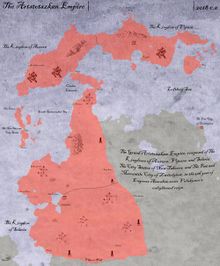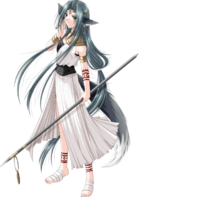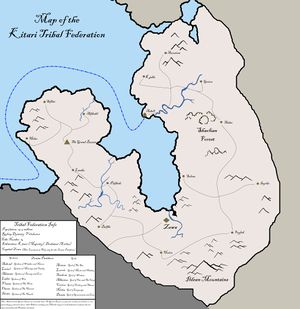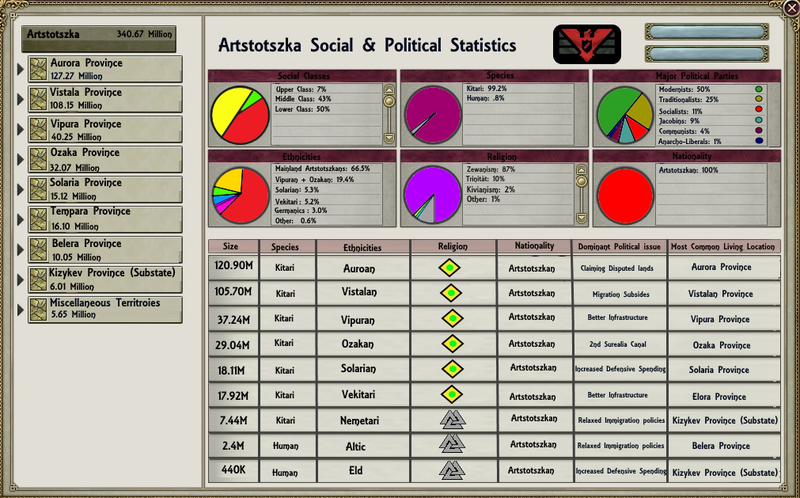Difference between revisions of "Artstotszka"
Artstotszka (Talk | contribs) |
Artstotszka (Talk | contribs) (→Ancient Migrations and The Takorran Stalemate (21,000 BCE - 18,100 BCE)) |
||
| Line 59: | Line 59: | ||
Now that the forced nomad-ism of the Kitari was temporarily stopped, their society flourished. Under the Tribal Federation, the Kitari would build many impressive communities, such as the Grand Bazaar, a place for the assorted tribes to trade goods, or Zewa, a "grand city" built in honor of the gods of the Kitari. [[File:ancient_city_by_hetnoodlot-d63p7p2.jpg|left|305px|thumb|A 16th century painting of Zewa, based on descriptions and texts]] The golden age was a very prosperous time for the Kitari, and this prosperity allowed Ausmi to cement her rule. She would eventually marry her long-time companion Kanadin, and start a family with him, beginning the Volukunov dynasty. To ensure the safety of her Kingdom for if she died in war, she declared that if she passed on, then Her oldest child would inherit the throne[[File:Kitari_Tribal_Federation_small.jpg|right|300px|thumb|The Kitari Tribal Federation, circa 18,500 BCE (Larger Version Available)]].. This would be the start of Primogeniture succession in Kitari society, and would be a critical moment in the founding of royal power She would also stop the more brutal elements of Drakatari culture, as well as stopping the ban on Immigration by either Porto-Heimarian Humans, or by Drakatari that were Banished long after the initial exilement. | Now that the forced nomad-ism of the Kitari was temporarily stopped, their society flourished. Under the Tribal Federation, the Kitari would build many impressive communities, such as the Grand Bazaar, a place for the assorted tribes to trade goods, or Zewa, a "grand city" built in honor of the gods of the Kitari. [[File:ancient_city_by_hetnoodlot-d63p7p2.jpg|left|305px|thumb|A 16th century painting of Zewa, based on descriptions and texts]] The golden age was a very prosperous time for the Kitari, and this prosperity allowed Ausmi to cement her rule. She would eventually marry her long-time companion Kanadin, and start a family with him, beginning the Volukunov dynasty. To ensure the safety of her Kingdom for if she died in war, she declared that if she passed on, then Her oldest child would inherit the throne[[File:Kitari_Tribal_Federation_small.jpg|right|300px|thumb|The Kitari Tribal Federation, circa 18,500 BCE (Larger Version Available)]].. This would be the start of Primogeniture succession in Kitari society, and would be a critical moment in the founding of royal power She would also stop the more brutal elements of Drakatari culture, as well as stopping the ban on Immigration by either Porto-Heimarian Humans, or by Drakatari that were Banished long after the initial exilement. | ||
| − | |||
All good things though, must come to an end. For every Drakatari that was killed in the war, 10 more were ready to take their place. After 900 years of on-and-off fighting, the Kitari were being crushed under the pressure of Attrition, and Ausmi realized that she either had to take Drastic Measures, or be eradicated by The Empire. So, taking her still-remaining subjects, she would erase almost all evidence of their society (including the fabled city of Zewa), and begin "the long migration" north, travelling all the way from Takorra (In present-day Southern Solaria) all the way to Northern Aurora. Audax's relative Ice age at the time made the place nearly inhospitable, leading to the deaths of as many as 90% of the Kitari due to cold and disease, eventually including Ausmi's husband, Kanadin. Ausmi and her offspring, however, had no such problems with these conditions; They had thick fur, useful tails, etc. As the gene pool shrunk, Ausmi's genetic traits spread throughout the populous due to natural selection and inbreeding (which does not have an adverse effect on Drakatari or their subspecies), leading to the transformation of the Kitari from a separate culture into a full-on race. | All good things though, must come to an end. For every Drakatari that was killed in the war, 10 more were ready to take their place. After 900 years of on-and-off fighting, the Kitari were being crushed under the pressure of Attrition, and Ausmi realized that she either had to take Drastic Measures, or be eradicated by The Empire. So, taking her still-remaining subjects, she would erase almost all evidence of their society (including the fabled city of Zewa), and begin "the long migration" north, travelling all the way from Takorra (In present-day Southern Solaria) all the way to Northern Aurora. Audax's relative Ice age at the time made the place nearly inhospitable, leading to the deaths of as many as 90% of the Kitari due to cold and disease, eventually including Ausmi's husband, Kanadin. Ausmi and her offspring, however, had no such problems with these conditions; They had thick fur, useful tails, etc. As the gene pool shrunk, Ausmi's genetic traits spread throughout the populous due to natural selection and inbreeding (which does not have an adverse effect on Drakatari or their subspecies), leading to the transformation of the Kitari from a separate culture into a full-on race. | ||
| Line 66: | Line 65: | ||
[WIP BELOW THIS POINT] | [WIP BELOW THIS POINT] | ||
| + | |||
===Colonial Era (1151 CE - 1410 CE)=== | ===Colonial Era (1151 CE - 1410 CE)=== | ||
In the Colonial Era Artstotszkan society would be put up to it's toughest test; in 1151 CE, The Altberg Empire would land soldiers in Eastern Artstotszka, claiming the island for the Altberg Empire. Emperor Arenar II would attempt to send the Army against the new invaders, but due to several factors such as under funded troops and less advanced technology, the Tribal Army would be crushed in what is known as the Massacre of Melinera. Emperor Arenar would then be forced to work with the colonials, ceding nearly half of Eastern Artstotszka to their control. For several decades, Bands of rebels in occupied territory would try to fight back against the Altbergians, though ever time they were defeated by the superior colonial forces. This would continue for 2 and a half centuries, when Artstotszka's chance would finally come with the unification of the kingdom of Hawkwick by Ragnar Ulfbert, which coincided with the coronation of Anya I, Who would try to make Artstotszka independent no matter the cost. She would start introducing large scale military reforms, such as introducing metal armor, swords, and crossbows. in addition, she would secretly import gunpowder weapons such as early cannons and muskets from Aglrinia. In 1408, she would both forever change the Kitari Tribal Federation into the Artstotszkan Empire, and formally declare war on the Altberg Empire (Rather than the Kingdom of Hawkwick, since the Altbergs were the ones who originally colonized the islands), and personally lead several victories with the new Artstotszkan Imperial Army.[[File:310x416 female knight.png|right|205px|thumb| An artist's depiction of Anya I]] The war would rage on for two more years until the remnants of the colonial forces fled by ship to nearby Vipura and Solaria. Empress Anya (By then known as Anya The Liberator) would use her power to reform and modernize the government, establishing a democratically elected parliament, as well as dissolving the tribal structure and revoking the law-making ability of the hgih council, making the only role of the high council is to advise the ruling monarch. | In the Colonial Era Artstotszkan society would be put up to it's toughest test; in 1151 CE, The Altberg Empire would land soldiers in Eastern Artstotszka, claiming the island for the Altberg Empire. Emperor Arenar II would attempt to send the Army against the new invaders, but due to several factors such as under funded troops and less advanced technology, the Tribal Army would be crushed in what is known as the Massacre of Melinera. Emperor Arenar would then be forced to work with the colonials, ceding nearly half of Eastern Artstotszka to their control. For several decades, Bands of rebels in occupied territory would try to fight back against the Altbergians, though ever time they were defeated by the superior colonial forces. This would continue for 2 and a half centuries, when Artstotszka's chance would finally come with the unification of the kingdom of Hawkwick by Ragnar Ulfbert, which coincided with the coronation of Anya I, Who would try to make Artstotszka independent no matter the cost. She would start introducing large scale military reforms, such as introducing metal armor, swords, and crossbows. in addition, she would secretly import gunpowder weapons such as early cannons and muskets from Aglrinia. In 1408, she would both forever change the Kitari Tribal Federation into the Artstotszkan Empire, and formally declare war on the Altberg Empire (Rather than the Kingdom of Hawkwick, since the Altbergs were the ones who originally colonized the islands), and personally lead several victories with the new Artstotszkan Imperial Army.[[File:310x416 female knight.png|right|205px|thumb| An artist's depiction of Anya I]] The war would rage on for two more years until the remnants of the colonial forces fled by ship to nearby Vipura and Solaria. Empress Anya (By then known as Anya The Liberator) would use her power to reform and modernize the government, establishing a democratically elected parliament, as well as dissolving the tribal structure and revoking the law-making ability of the hgih council, making the only role of the high council is to advise the ruling monarch. | ||
Revision as of 20:22, 13 April 2016
| The Grand Empire of Artstotszka (Artstotszka)
|
|||
|---|---|---|---|
|
|||
| Motto: Glory to Artstotszka! | |||
| Anthem: Military's Honor. | |||
Artstotszka's location in Audax.
|
|||
| Capital and largest city | Paradizna | ||
| Official languages | English, Altic | ||
| Ethnic groups | Kitari (95.24%), Altic (4.23%), Eld (0.23%), Other (0.20%) | ||
| Demonym | Artstotszkan | ||
| Government | Monarchy | ||
| - | Empress/Emperor | Annalise XVIII | |
| - | Speaker of the House | James Petrov | |
| - | Chief Justice | Alice Kalinsky | |
| Empire | |||
| - | Initial Exile from Vandinium | ~21,000 BCE | |
| - | Ausmi's Uniting the tribes | ~19,000 BCE | |
| - | The Long Migration | ~18,100 BCE | |
| - | The Altbergian Colonization | ~1100 CE | |
| - | The Abolition of the Tribes | May 3rd, 1381 CE | |
| - | Recognition of Kitari Independence | June 1st, 1410 CE | |
| - | Establishing of The Empire of Artstotszka | December 11th, 1612 CE | |
| Population | |||
| - | estimate | 340.67 Million | |
| Currency | (ANC)a (U$) |
||
| Time zone | AT-5 <-> AT-2 | ||
| Date format | D/M/YYYY | ||
| Calling code | +077 | ||
| Internet TLD | .asz | ||
The Empire of Artstotszka (Artstotszkan Empire, or The Grand Empire of Artstotszka), commonly referred to as Artstotszka, is a Constitutional Monarchy consisting of 5 component nations. The 3 Kingdoms (The Kingdoms of Aurora, Vipura, and Solaria) are on the the Western portion of the Continent, between Heimar (now apart of the Altic Union with Hawkwick) and Vandinium. The other two component states are The City States of New Takorra, located to the west of Aurora, and the Free and Mercantile City of Zwitelgiest, an Enclave on Heimar's Eastern Coast.
Ancient Kitari migrated from Ancient Vandinium to what is now the Artstotszkan mainland around 19,000 years ago, with Hawkwickian (Attempted) colonization beginning in the 12th century. The Kingdom of Aurora emerged from the Artstotszkan Tribal union, the lose amalgamation of Kitari tribes inhabiting the land (However, the monarchy line existed long before these events, with the royal line beginning 21,000-19,500 years ago)
Driven by the desire to evict their colonial oppressors , as well as seize the valuable land, Aurora embarked on a Massive expansion across the continent throughout the 17th-19th centuries. This involved displacing colonial settlers, acquiring new territories, and gradually annexing said territories into the country proper. A succession crisis in the 17th century would lead to the Empire of Artstotszka being established, made up of Kitari Kingdoms. By the end of the 19th century, Artstotszka had secured Solaria, and its economy began to soar. The Solarian Wars with Heimar and Vandinium and the 'Winter War'with Hawkwick confirmed the country's status as military power. Artstotszka emerged from the 20th century as a regional power, and the 3rd country with nuclear weapons. Artstotszka is a developed country, and the economy is fueled by an abundance of natural resources and high worker productivity.
Contents
Ancient Migrations and The Takorran Stalemate (21,000 BCE - 18,100 BCE)
Unlike most species, The Kitari began not due to Natural Selection or Mutations, but rather due to Politics. In the Anceint Drakatari Empire, bureaucratic disputes were common. In one of the larger disputes, members on their governing council conspired to have their rivals and their supporters removed from the picture (primarily anyone with liberal-leaning ways, since they were forwned upon heavily by the conservative Drakatari Empire). Since Execution of an entire 3rd of the council and their numerous supporters would be barbaric, the council instead agreed to have these citizens exiled to the Northern border of the Empire.
When the Original Exile happened, the 'Exiles' were still Drakatari, following their religion and speaking their language. As their isolation continued and they interbred with the Native Humans, their culture began to branch off, with the same thing occurring to their language. To many of the Drakatari in the Empire, the exiles, now called "Kitari", were no longer civilized people. They then expanded their borders north, forcing the Kitari to move further northwards while simultaneously settling the now-empty Kitari urban centers with Drakatari subjects. This would be a cyclical process, repeating every few decades, forcing the Kitari further and further North into increasingly inhospitable lands. In an attempt to delay their eradication, The Kitari would then establish the Tribal Federation, a largely-symbolic union that tended to only act united when the Drakatari invaded.
This would all change around 19,000 BCE with the appearance of a young 16 year old girl named Ausmi. While her past and origin were completely unknown, she was an enigma to the Kitari leaders. Possessing Purple Fur (An incredibly rare color among Drakatari), Canine like-traits (as opposed to feline-like), and mystical powers of fire, she very quickly managed to rally the squabbling tribes under her leadership. She would lead them to Victory against the Armies of Cessius, one of the Empire's best commanders, in 18,994 BCE. This attack would completely halt the Drakatari advance. The mere appearance of Ausmi, made worse by this massive defeat, shook Cessius to the bone, causing him to leave the Northern border and get re-assigned to the quiet Eastern Border. For the next nine hundred years, Ausmi would fight against the Drakatari Legions, earning her a fearsome reputation and gaining the complete allegiance of the Kitari, who crowned her "High Chieftess of the Tribes", roughly the equivalent of the rank 'Queen'. Due to her mysticism and military skill, she was known by the moniker "The Dragon of The North", which eventually turned into "Ice Dragon". She would eventually adopt this name for herself to supplement her lack of a clan name, and from then on she was "Ausmi Volukunov, High Chieftess of the Kitari". (In Ancient Kitari, Vol was the word for Ice, and Ukunov was the closest translation of Dragon). Now that the forced nomad-ism of the Kitari was temporarily stopped, their society flourished. Under the Tribal Federation, the Kitari would build many impressive communities, such as the Grand Bazaar, a place for the assorted tribes to trade goods, or Zewa, a "grand city" built in honor of the gods of the Kitari. The golden age was a very prosperous time for the Kitari, and this prosperity allowed Ausmi to cement her rule. She would eventually marry her long-time companion Kanadin, and start a family with him, beginning the Volukunov dynasty. To ensure the safety of her Kingdom for if she died in war, she declared that if she passed on, then Her oldest child would inherit the throne.. This would be the start of Primogeniture succession in Kitari society, and would be a critical moment in the founding of royal power She would also stop the more brutal elements of Drakatari culture, as well as stopping the ban on Immigration by either Porto-Heimarian Humans, or by Drakatari that were Banished long after the initial exilement.All good things though, must come to an end. For every Drakatari that was killed in the war, 10 more were ready to take their place. After 900 years of on-and-off fighting, the Kitari were being crushed under the pressure of Attrition, and Ausmi realized that she either had to take Drastic Measures, or be eradicated by The Empire. So, taking her still-remaining subjects, she would erase almost all evidence of their society (including the fabled city of Zewa), and begin "the long migration" north, travelling all the way from Takorra (In present-day Southern Solaria) all the way to Northern Aurora. Audax's relative Ice age at the time made the place nearly inhospitable, leading to the deaths of as many as 90% of the Kitari due to cold and disease, eventually including Ausmi's husband, Kanadin. Ausmi and her offspring, however, had no such problems with these conditions; They had thick fur, useful tails, etc. As the gene pool shrunk, Ausmi's genetic traits spread throughout the populous due to natural selection and inbreeding (which does not have an adverse effect on Drakatari or their subspecies), leading to the transformation of the Kitari from a separate culture into a full-on race.
[WIP BELOW THIS POINT]
Colonial Era (1151 CE - 1410 CE)
In the Colonial Era Artstotszkan society would be put up to it's toughest test; in 1151 CE, The Altberg Empire would land soldiers in Eastern Artstotszka, claiming the island for the Altberg Empire. Emperor Arenar II would attempt to send the Army against the new invaders, but due to several factors such as under funded troops and less advanced technology, the Tribal Army would be crushed in what is known as the Massacre of Melinera. Emperor Arenar would then be forced to work with the colonials, ceding nearly half of Eastern Artstotszka to their control. For several decades, Bands of rebels in occupied territory would try to fight back against the Altbergians, though ever time they were defeated by the superior colonial forces. This would continue for 2 and a half centuries, when Artstotszka's chance would finally come with the unification of the kingdom of Hawkwick by Ragnar Ulfbert, which coincided with the coronation of Anya I, Who would try to make Artstotszka independent no matter the cost. She would start introducing large scale military reforms, such as introducing metal armor, swords, and crossbows. in addition, she would secretly import gunpowder weapons such as early cannons and muskets from Aglrinia. In 1408, she would both forever change the Kitari Tribal Federation into the Artstotszkan Empire, and formally declare war on the Altberg Empire (Rather than the Kingdom of Hawkwick, since the Altbergs were the ones who originally colonized the islands), and personally lead several victories with the new Artstotszkan Imperial Army. The war would rage on for two more years until the remnants of the colonial forces fled by ship to nearby Vipura and Solaria. Empress Anya (By then known as Anya The Liberator) would use her power to reform and modernize the government, establishing a democratically elected parliament, as well as dissolving the tribal structure and revoking the law-making ability of the hgih council, making the only role of the high council is to advise the ruling monarch.Modernization Era (1410 CE - 1818 CE)
The ramifications of Anya I's reforms would continue to be felt in Artstotszkan society, with the tradionalist/modernist divide being present in Artstotszkan politics even in the modern age. The new government would be have turbulent early years, dealing with diplomacy with foreign nations and managing the newly reclaimed lands. Another upheavel in kitari society would be in 1449, when the Great Schism happened within the Zewanist faith. While this was happening, repeated attempts by modernists to end Artstotszka's isolation were blocked, and Artstotszka's first war of expansion would be in 1611. 12 years into Lydia I's reign, several prominent high council members convinced her to invade the Blackhorn dominion. in a quick campaign lasting 9 months, Artstotszka would triumph over the dominion and annex Vipura, which also led to Artstotszka having a large germanic population as subjects.
Expansion Era (1818 CE - 1947 CE)
Born in 1801, Viktor I Volukunov was 17 when he was crowned emperor in 1818. A modernist (the first true modernist monarch), Viktor quickly set his sights on the lands of Solaria, and began preparing the army for war. Due to the isolation of artstotszka, Many of the tech advances made in the country, such as repeating rifles and the first military vehicles, ha yet to spread to nearby countries. This gave him confidence, so on June 1st, 1821, Artstotszka would formally declare war on Colonial Vandinium and The Kingdom of Heimar , and begin blitzing Solaria. This had the unfortunate consequence in the loss of Zwitelgeist, which was occupied by Heimar forces several days after the war began. Viktor would split his forces, with half going east towards heimar and half going south towards Vandinium. by January of 1819, the Artsotszkan advance in the south had slowed down, mainly in part due to the Vandinite army under the control of General Cessius Tessari, who would implement trench warfare and force the Artstotszkan advance grind to a halt, stalemating both sides along what is close to the current border. Despite Artstotszkan advances such as prototype tanks and aircraft, the Army could not evict the Vandinite troops. this, coupled with a renewed Heimar offensive in the east, along with the heavy casualties incurred fighting Vandinum, forced Viktor to prematurely end the war with the Treaty of Solaria in 1821. Despite the massive territorial gains made by Artstotszka, Viktor I (later known as "Viktor the Conqueror"), an orthodox Zewan, would continue to think of the war as a failure, due to his failure to reclaim Zewa and the loss of Zwitelgiest.Industrialization
In the Artstotszkan Mainland, urbanization and an unprecedented population boom supplied a surplus of labor for the country's industrialization and transformed its culture. National infrastructure including telegraph and railroads spurred economic growth. The later invention of electric lights and telephones would also impact communication and urban life. The end of the Expansion Wars further expanded Artstotszka. In 1824 Artstotszka claimed the island of Elora, a Major trade port between the southern island nations, and the northern mainland nations.
Rapid economic development at the end of the 19th century produced many prominent industries, and the Artstotszkan economy became the world's 5th largest. Dramatic changes by Emperor James XXI were accompanied by large Socialist reforms and policies,as well as protests.
Modern Era
Artstotszka became major player on the world stage after the coup of Aglrinian dictator Generalissimo Menon. This , followed by the outbreak of Civil war in Hawkwick and vandinium, and the coronation of the Empire's first Colonial Born Empress (Annalise XVIII) has made many uncertain about Artstotszka's future, with a growing movement among the populace to take the title of "Regional Superpower". In 2014, Artstotszka would intervene in the Hawkwick Civil war on the side of Heimar and the NFA. Artstotszkan contributions would include a blockade of Blackhorn, the destruction of an HNA base in Vipura, and Artstotszkan Paratroopers taking part in the Battle of New Altberg. In Late 2015, the province of Kizykev would become a Substate of Artstotszka, as The Kingdom of East Vipura, ruled by Queen Isabella IV.
Geography
The land area of The Artstotszkan Empire is 16,000,000 square miles. Artstotszka is the world's 4th largest nation by total area (land and water), ranking behind Aglrinia, Nervousa and the Altic Union and above Wahland and Vandinium. The coast of the Mainland is large and forest-covered, with the Zyvan mountain Range separating Heimar and Artstotszka (excluding the Grestin valley, containing the Divided city of Grestin). The Artstotszkan mainland is very Flat, with much of it's land producing crops, or sprawling buildings near urban areas. Vipura is forested and hilly, combined with it's cold climate, creates a harsh environment for those living their, a fact balanced by the massive amount of resources in the area, such as Oil, Nickel, Iron, Uranium, etc.
Population
With a birth rate of 5,5 Children per couple, Artstotszka has a significantly higher birth rate than those of many developed nations. In 2010, the Artstotszkan population included an estimated 5.2 million Hawkwickian immigrants with no kitari relations (However, due to the common inter-species marriage between kitari and Humans, few hawkwickians will have human children, this stifling growth of the Human Minority).
About 71% of Artstotszkans live in urban areas (including suburbs); about half of those reside in cities with populations over 500,000. In 2008, 14 Cities had populations over 2 million, 5 cities had more than 5 million residents, and 2 cities had s population of over 10 million (Paradizna and Elecktrozavodsk).
Leading population centers:
| City | Population | Province |
|---|---|---|
| Elecktrozavodsk | 17,002,431 | Aurora |
| Paradizna | 12,912,430 | Aurora |
| New Elecktrozavodsk | 7,890,024 | Vipura |
| Solaria City | 6,023,856 | Solaria |
| Nirsk | 3,230,119 | Vistala |
| Chernogorsk | 2,910,002 | Vistala |
| Novy Sobor | 2,546,284 | Vistala |
| Surealia | 2,420,337 | Ozaka |
| Stary Sobor | 1,328,090 | Vistala |
| Orvech Venor | 1,124,768 | Vistala |
Government
The National government is composed of two branches:
Legislative: Made up of The High Council and Parliament, Parliament can make laws and declare war. While Parliament is elected democratically, High council members are made up of the nobility, however they have no voting power and can only advise the Current Monarch on maters (however, their opinion is highly valued)
Executive: The Reigning Monarch is the commander-in-chief of the military, can reject legislative bills before they become law, Sign treaties with foreign nations, ask parliament to declare war (though not actually required), or negotiate with foreign leaders.










